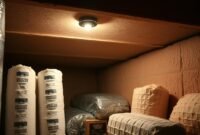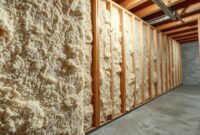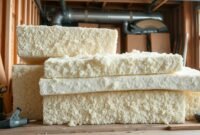Cold, damp basements can make your home less comfortable and more expensive. Drafty walls let heat escape, raising your bills and making your home feel chilly. It’s like having a cold room in your house.
The basement wall insulation blanket is a great fix. It acts as a thermal barrier, stopping heat loss and saving energy. This simple change can make your basement warm and efficient, saving you money too.
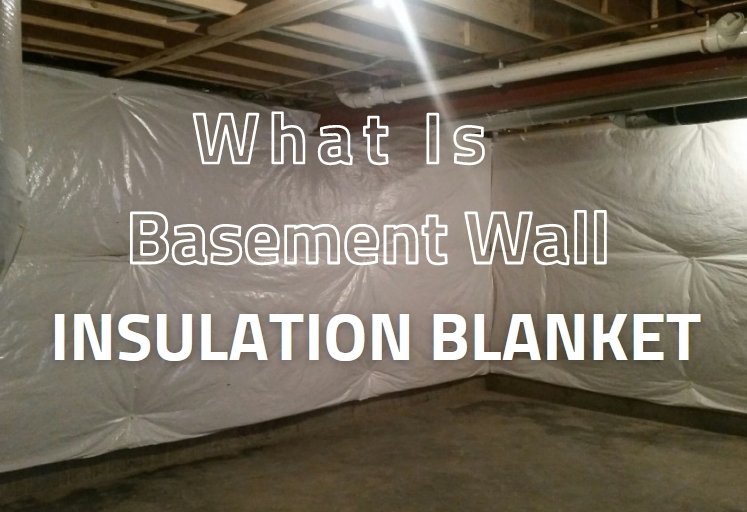
Understanding Basement Heat Loss and Energy Efficiency
As a homeowner, I’ve found a hidden energy drain: basement heat loss. Uninsulated basement walls waste a lot of energy, up to 25 percent of your home’s heat. This shows how important energy-efficient insulation for basement walls is.
The science behind basement heat loss is simple. Basement walls touch the ground, creating a thermal environment that affects your home’s energy use. Without insulation, these walls pull warmth from your living areas.
Read also: R13 Insulation For Basement Walls
Key Factors Contributing to Heat Loss
- Direct ground contact with basement walls
- Temperature differences between indoor and outdoor environments
- Lack of proper basement wall insulation
- Gaps and cracks in foundation walls
Learning about basement wall insulation was eye-opening. The right insulation stops heat from escaping. This boosts your home’s energy efficiency and lowers your utility bills.
The Impact of Uninsulated Basements
Without the right insulation, your basement weakens your home’s thermal envelope. Cold walls make your home less comfortable, raise heating costs, and can cause moisture damage.
The Science Behind Basement Wall Insulation Blanket
To understand blanket insulation for basements, we must explore thermal protection. Wall blanket insulation is a complex system. It acts as a shield against heat loss and moisture in basements.
The main role of a basement wall insulation blanket is based on science. These materials block heat transfer and prevent moisture. They also stop mold and damage, and boost energy efficiency.
- Blocking thermal transfer between interior and exterior spaces
- Preventing moisture condensation
- Reducing the risk of mold and structural damage
- Improving overall energy efficiency
Various materials bring different benefits to wall blanket insulation. Fiberglass, mineral wool, and synthetic composites each have unique heat and moisture management abilities.
| Insulation Material | Thermal Resistance (R-Value) | Moisture Resistance |
|---|---|---|
| Fiberglass Blanket | R-13 to R-15 | Moderate |
| Mineral Wool | R-15 to R-23 | High |
| Synthetic Composite | R-10 to R-20 | Excellent |
Using advanced insulation technologies can greatly lower energy use. It makes basements warmer and drier. This turns basements into cozy, energy-saving spaces.
Types of Basement Insulation Materials
Choosing the right insulation for your basement is key to a cozy home. Not all insulation is the same. Each type has its own benefits and challenges.
When picking insulation blankets, think about a few things. The best choice depends on your needs, budget, and where you live.
Fiberglass Blanket Insulation
Fiberglass insulation is a favorite among homeowners. It’s affordable and easy to put up. These blankets fit standard wall spaces well.
- Affordable pricing
- Widely available
- Good thermal resistance
- Lightweight and flexible
Rigid Foam Board Options
Rigid foam boards are great for keeping moisture out and insulating well. They’re perfect for humid areas.
| Foam Type | R-Value per Inch | Moisture Resistance |
|---|---|---|
| Expanded Polystyrene (EPS) | 3.6-4.0 | Good |
| Extruded Polystyrene (XPS) | 4.5-5.0 | Excellent |
| Polyisocyanurate (Polyiso) | 5.5-6.0 | Very Good |
Spray Foam Alternatives
Spray foam insulation seals air tight and fills gaps. It’s pricier but insulates and controls moisture well.
- Exceptional air sealing properties
- High R-value
- Prevents moisture intrusion
- Reduces mold growth risk
Knowing about these insulation types helps you choose wisely. This choice can make your home more energy-efficient and comfortable.
Benefits of Proper Basement Wall Insulation
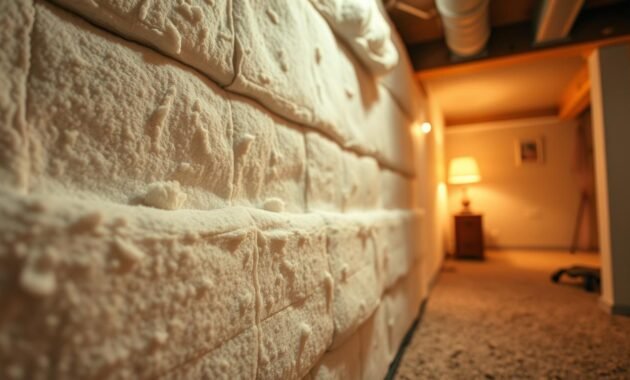
Homeowners gain a lot from insulating their basement walls. It’s not just about keeping the temperature right. Insulating your basement walls is a smart move. It makes your home more comfortable and efficient.
Energy efficiency is a big plus. Insulation acts as a thermal barrier, cutting down on heat loss. This leads to lower energy bills and a cozy home.
- Reduces monthly heating and cooling costs
- Prevents cold drafts and temperature fluctuations
- Increases overall home energy efficiency
- Improves indoor air quality
Moisture protection is another key benefit. Insulation keeps water out, preventing damage and mold. This keeps your home safe and healthy for your family.
Don’t forget about the boost to your home’s value. A well-insulated basement is attractive to buyers. It shows your home is well cared for, which can increase its value.
- Prevents moisture-related damage
- Reduces risk of mold and mildew
- Enhances home resale value
- Creates additional usable living space
Experts suggest pairing insulation with other upgrades like waterproofing. This combo offers the best protection and efficiency for your home.
Installation Techniques for Basement Wall Insulation Blanket
Installing a basement wall insulation blanket can make your home more energy-efficient and cozy. As someone who has done insulation projects before, I’ll show you how to install it like a pro.
First, get the right stuff and prep your basement walls. For buying basement wall blanket insulation, check out Home Depot or Lowe’s. They have lots of choices.
Preparation Steps
Getting ready is key for a good insulation job. Here’s what to do:
- Clean the basement walls well, getting rid of dirt, moisture, and loose stuff
- Look for any moisture problems or water damage
- Fix any cracks or structural issues before you insulate
- Measure the wall right
- Make sure there’s good air flow while you install
Application Methods
When putting on the insulation blanket, be precise. Cut it to fit your wall size. Press it tight against the wall, making sure there are no gaps.
- Use mechanical fasteners to hold it in place
- Make sure seams overlap to keep heat in
- Seal edges with tape or caulk
Common Installation Mistakes to Avoid
Even pros can mess up when installing insulation. Watch out for these mistakes:
- Not using a moisture barrier
- Leaving gaps between panels
- Not prepping the walls well
- Choosing the wrong insulation for your basement
By following these tips, you’ll make your basement more energy-efficient and comfy. Always focus on doing it right with insulation materials.
Moisture Control and Vapor Barriers
Keeping moisture under control is vital when insulating basements. I learned from my basement renovation projects that moisture can be a big problem. Moisture-resistant insulation is essential to protect your home’s structure and air quality.
Read also: What is the Best Insulation for Basement Ceiling?
Vapor barriers are important for basement wall insulation. They stop moisture from getting into your basement walls. This can prevent mold and damage. When I started my basement insulation project, I learned how to manage moisture effectively.
- Install vapor barriers directly against basement walls
- Choose moisture-resistant insulation materials
- Ensure proper sealing around edges and penetrations
- Use breathable insulation that allows minimal moisture transfer
Different insulation types offer different moisture protection levels. Rigid foam board and closed-cell spray foam are great for keeping moisture out. They are perfect for humid underground spaces.
Getting a professional to install insulation is important for good moisture control. I suggest hiring experienced contractors who know basement challenges. They can pick the best insulation and apply it correctly to avoid future moisture problems.
Cost Analysis and Return on Investment
Getting a basement wall insulation blanket might seem pricey at first. But, the long-term savings make it a wise choice for your home. Knowing the cost and how it saves energy is key for homeowners wanting a more efficient home.
When looking at energy-saving insulation, there are important financial points to consider. These help you make a well-informed choice.
Material Expenses
The price of basement wall insulation depends on a few things:
- Fiberglass blanket insulation: $1.50 – $2.50 per square foot
- Rigid foam board: $2.50 – $4.00 per square foot
- Spray foam alternatives: $3.00 – $5.00 per square foot
Installation Costs
Adding professional installation increases the cost. Labor costs are usually $1.50 to $3.00 per square foot. For a typical basement, expect to pay between $2,000 and $6,000 total.
Energy Savings Projections
The real benefit is in the long-term energy savings. A well-insulated basement can cut heating and cooling costs by 10-20% each year. This could save an average home $200-$400 annually.
Pro tip: Look into local utility rebates like Mass Save®. They can help cover the cost of installation. Some rebates offer up to 75% off for energy-saving upgrades.
My advice? Figure out your specific return on investment. Compare the cost of installation to the savings on energy bills. Most homeowners see their money back in 5-7 years through lower bills.
Interior vs Exterior Insulation Approaches
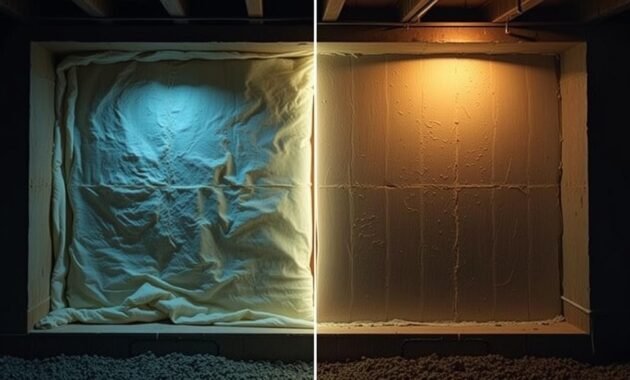
Homeowners have to decide between interior and exterior insulation for their basements. Each method has its own benefits for keeping your home warm and energy-efficient.
Interior basement insulation includes a few main steps:
- Installing rigid foam insulation boards directly against basement walls
- Creating wood-frame walls with fiberglass or mineral wool insulation
- Adding drywall for a finished appearance
Exterior basement insulation needs more work but offers better protection:
- Excavating around the home’s foundation
- Applying waterproofing membranes
- Installing specialized exterior insulation panels
I usually suggest interior basement insulation for most people. It’s cheaper and less invasive. It also doesn’t require big changes to your yard. But, exterior insulation is better for homes with a lot of moisture or during new builds.
The best insulation choice depends on your home, budget, and energy goals. Talking to a professional can help you choose the best option for your situation.
Building Code Requirements and Safety Considerations
Understanding basement insulation is complex. It involves knowing building codes and safety rules. As a homeowner, I’ve found that insulation is more than just adding material. Local and national codes are key to a safe and efficient insulation job.
When you start on basement insulation, you need to think about safety:
- Fire resistance ratings for insulation materials
- Proper ventilation requirements
- Moisture control and prevention
- Compliance with local building codes
Energy-efficient insulation is not just about saving money. It’s also about making your home safe. The International Residential Code (IRC) has rules for basement insulation. These cover material choice and how to install it.
Important safety tips for basement insulation are:
- Choosing insulation that’s fire-resistant
- Making sure there’s enough air gaps and ventilation
- Keeping moisture away to prevent mold
- Having the right thermal barriers
Many basements don’t have enough insulation, which is a big chance to improve your home. When you’re planning your insulation project, talk to local building inspectors and contractors. They can help make sure you follow all safety and building code rules.
Conclusion
Exploring basement wall insulation has shown me it’s more than a simple upgrade. It’s about making your basement comfortable and energy-efficient. This also helps protect your home’s foundation and lowers energy costs.
Understanding basement finishing highlights the need for proper insulation. Soundproof insulation is not just a luxury. It’s a practical solution that greatly improves your living space. Programs like Mass Save® make this investment easier, helping homeowners save on energy without spending too much.
From my experience, the benefits are more than I expected. A well-insulated basement means lower energy bills and better comfort. It also protects against moisture damage. Whether you want a cozy living area or better home performance, quality insulation is a wise choice.
If you’re thinking about upgrading your basement, start now. The right insulation can turn your basement into a valuable part of your home. It makes your basement more than just a forgotten space.
